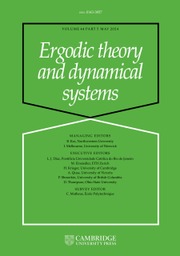Article contents
Deviation for interval exchange transformations
Published online by Cambridge University Press: 01 December 1997
Abstract
Consider a long piece of a trajectory $x, T(x), T(T(x)), \ldots, T^{n-1}(x)$of an interval exchange transformation $T$. A generic interval exchangetransformation is uniquely ergodic. Hence, the ergodic theorem predicts thatthe number $\chi_i(x,n)$ of visits of our trajectory to the $i$th subintervalwould be approximately $\lambda_i n$. Here $\lambda_i$ is the length of thecorresponding subinterval of our unit interval $X$. In this paper we give anestimate for the deviation of the actual number of visits to the $i$thsubinterval $X_i$ from one predicted by the ergodic theorem.
We prove that for almost all interval exchangetransformations the following bound is valid:$$\max_{\ssty x\in X \atop \ssty 1\le i\le m}\limsup_{n\to +\infty} \frac {\log | \chi_i(x,n) -\lambda_in|}{\log n}= \frac{\theta_2}{\theta_1} < 1.$$Roughly speaking the error term is bounded by $n^{\theta_2/\theta_1}$. Thenumbers $0\le \theta_2 < \theta_1$ depend only on the permutation $\pi$corresponding to the interval exchange transformation (actually, only on theRauzy class of the permutation). In the case of interval exchange of twointervals we obviously have $\theta_2=0$. In the case of exchange of threeand more intervals the numbers $\theta_1, \theta_2$ are the two top Lyapunovexponents related to the corresponding generalized Gauss map on the space ofinterval exchange transformations.
The limit above ‘converges to the bound’ uniformly forall $x\in X$ in the following sense. For any $\varepsilon >0$ the ratioof logarithms would be less than $\theta_2(\pi)/\theta_1(\pi)+\varepsilon $for all $n\ge N(\varepsilon)$, where $N(\varepsilon)$ does not depend on thestarting point $x\in X$.
Information
- Type
- Research Article
- Information
- Copyright
- 1997 Cambridge University Press
- 75
- Cited by

